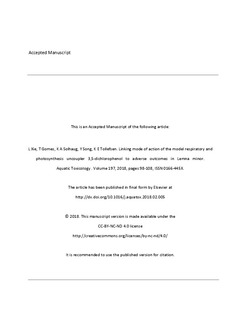| dc.contributor.author | Xie, Li | |
| dc.contributor.author | Gomes, Tania | |
| dc.contributor.author | Solhaug, Knut Asbjørn | |
| dc.contributor.author | Song, You | |
| dc.contributor.author | Tollefsen, Knut Erik | |
| dc.date.accessioned | 2019-06-20T11:49:21Z | |
| dc.date.available | 2019-06-20T11:49:21Z | |
| dc.date.created | 2018-07-10T11:31:30Z | |
| dc.date.issued | 2018 | |
| dc.identifier.citation | Aquatic Toxicology. 2018, 197, 98-108. | nb_NO |
| dc.identifier.issn | 0166-445X | |
| dc.identifier.uri | http://hdl.handle.net/11250/2601548 | |
| dc.description | Embargo until 10 February 2020. | nb_NO |
| dc.description.abstract | Standard chemical toxicity testing guidelines using aquatic plant Lemna minor have been developed by several international standardisation organisations. Although being highly useful for regulatory purposes by focusing on traditional adverse endpoints, these tests provide limited information about the toxic mechanisms and modes of action (MoA). The present study aimed to use selected functional assays in L. minor after exposure to 3,5-dichlorophenol (3,5-DCP) as a model to characterise the toxic mechanisms causing growth inhibition and lethality in primary producers. The results demonstrated that 3,5-DCP caused concentration-dependent effects in chloroplasts and mitochondria. Uncoupling of oxidative phosphorylation (OXPHOS), reduction in chlorophyll (Chlorophyll a and b) content, reproduction rate and frond size were the most sensitive endpoints, followed by formation of reactive oxygen species (ROS), lipid peroxidation (LPO), reduction of carotenoid content and impairment of photosynthesis efficiency. Suppression of photosystem II (PSII) efficiency, electron transport rate (ETR), chlorophyll (a and b) contents and oxidative phosphorylation (OXPHOS) were closely correlated while ROS production and LPO were negative correlated with ETR, carotenoid content and growth parameters. A network of conceptual Adverse Outcome Pathways (AOPs) was developed to decipher the causal relationships between molecular, cellular, and apical adverse effects occurring in L. minor to form a basis for future studies with similar compounds. | nb_NO |
| dc.language.iso | eng | nb_NO |
| dc.publisher | Elsevier | nb_NO |
| dc.rights | Attribution-NonCommercial-NoDerivatives 4.0 Internasjonal | * |
| dc.rights.uri | http://creativecommons.org/licenses/by-nc-nd/4.0/deed.no | * |
| dc.title | Linking mode of action of the model respiratory and photosynthesis uncoupler 3,5-dichlorophenol to adverse outcomes in Lemna minor | nb_NO |
| dc.title.alternative | Linking mode of action of the model respiratory and photosynthesis uncoupler 3,5-dichlorophenol to adverse outcomes in Lemna minor | nb_NO |
| dc.type | Journal article | nb_NO |
| dc.type | Peer reviewed | nb_NO |
| dc.description.version | acceptedVersion | nb_NO |
| dc.source.pagenumber | 98-108 | nb_NO |
| dc.source.volume | 197 | nb_NO |
| dc.source.journal | Aquatic Toxicology | nb_NO |
| dc.identifier.doi | 10.1016/j.aquatox.2018.02.005 | |
| dc.identifier.cristin | 1596522 | |
| dc.relation.project | Norges forskningsråd: 223268 | nb_NO |
| cristin.unitcode | 7464,20,13,0 | |
| cristin.unitname | Økotoksikologi | |
| cristin.ispublished | true | |
| cristin.fulltext | postprint | |
| cristin.qualitycode | 2 | |

